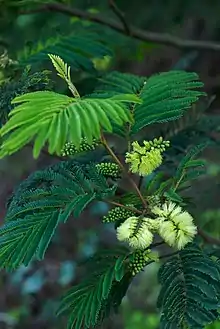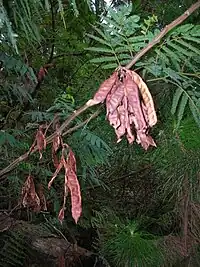Paraserianthes
Paraserianthes lophantha (syn. Albizia lophantha), the Cape Leeuwin wattle, Bicol wattle, Cape wattle, crested wattle or plume albizia, is a fast-growing tree with creamy-yellow, bottlebrush like flowers.[4] It is the sole species in genus Paraserianthes.[5]
| Paraserianthes | |
|---|---|
 | |
| Scientific classification | |
| Kingdom: | Plantae |
| Clade: | Tracheophytes |
| Clade: | Angiosperms |
| Clade: | Eudicots |
| Clade: | Rosids |
| Order: | Fabales |
| Family: | Fabaceae |
| Subfamily: | Caesalpinioideae |
| Clade: | Mimosoid clade |
| Genus: | Paraserianthes I.C.Nielsen (1983) |
| Species: | P. lophantha |
| Binomial name | |
| Paraserianthes lophantha | |
| Synonyms[3] | |
| |
It is a small tree (uppermost height approximately 5 metres) that occurs naturally along the southwest coast of Western Australia, from Fremantle to King George Sound.[6] It is also native to Sumatra, Java, and the Lesser Sunda Islands.[3] It was first spread beyond southwest Australia by Baron Ferdinand von Mueller, who gave packets of P. lophantha seeds to early explorers under the assumption that if they planted the seeds at their campsites, the trees would indicate the routes they travelled.[7]
It is considered a weed in the parts of Australia where it is not indigenous,[8] as well as in New Zealand, South Africa, the Canary Islands, the Philippines and Chile.[9]
Taxonomy
It was first described in 1806 as Acacia lophantha by Willdenow, but was transferred to the genus Paraserianthes by Nielsen, Guinet and Baretta-Kuipers in 1983.[1][2]
The genus Paraserianthes originally comprised four species, divided into two sections based on morphological traits by Nielsen.[10][11] Section Paraserianthes included P. lophantha with two recognized subspecies, and section Falcataria included three species (P. falcataria, P. pullenii, and P. toona).[10][11]
Based on morphology P. falcataria (L.) I.C.Nielsen was moved to the genus Falcataria by Barneby and Grimes,[12] and renamed Falcataria moluccana (Miq.) Barneby & J.W.Grimes.[12] Brown et al. used biogeographical, morphological and molecular studies to completely separate of these sections into two genera as Paraserianthes sensu Nielsen was paraphyletic.[13] Now P. pullenii (Verdc.) I.C. Nielsen[10][11] = Falcataria pullenii (Verdc.) G.K. Brown, D.J. Murphy & P.Y. Ladiges;[13] and P. toona (F.M. Bailey) I.C. Nielsen[10][11] = Falcataria toona (Bailey), G.K. Brown, D.J. Murphy & P.Y. Ladiges.[13] Paraserianthes section remained in the genus with only Paraserianthes lophantha.[13]
Subspecies
This species includes two subspecies:[13]
- P. lophantha subsp. lophantha in southwestern Australia
- P. lophantha subsp. montana (Jungh.) I.C. Nielsen in high elevation sites in Western Indonesia (Sumatara, Java and Western Nusa Tenggara Province).

.jpg.webp)
References
- "Paraserianthes lophantha". Australian Plant Name Index, IBIS database. Centre for Plant Biodiversity Research, Australian Government.
- Nielsen, I.; Baretta-Kuipers, T.; Guinet, P. (1983). "Studies in the Malesian, Australian and Pacific Ingeae (Leguminosae-Mimosoideae): the genera Archidendropsis, Wallaceodendron, Paraserianthes, Pararchidendron and Serianthes (part 1)". Bulletin du Muséum national d'histoire naturelle. Section B, Adansonia. 5 (3): 326. ISSN 0240-8937. Wikidata Q101031463.
- Paraserianthes lophantha (Vent.) I.C.Nielsen. Plants of the World Online. Retrieved 13 September 2023.
- The Legume Phylogeny Working Group (LPWG). (2017). "A new subfamily classification of the Leguminosae based on a taxonomically comprehensive phylogeny". Taxon. 66 (1): 44–77. doi:10.12705/661.3.
- Paraserianthes I.C.Nielsen. Plants of the World Online. Retrieved 13 September 2023.
- "Paraserianthes lophantha (synonym Albizia lophantha)". 2003-12-16. Retrieved 2008-09-28.
- "Weeds Australia - Weed Identification - Cape Leeuwin wattle". www.weeds.org.au. Archived from the original on 2008-08-04.
- "Weed of the month archive". Angair Inc. Retrieved 2013-08-27.
- "Paraserianthes lophantha (Willd.) I.C.Nielsen". www.gbif.org. Retrieved 2020-10-31.
- Nielsen, I., Guinet, P., Baretta-Kuipers, T., 1983. Studies in the Malesian, Australian and Pacific Ingeae (Leguminosae - Mimosoideae): the genera Archidendropsis, Wallaceodendron, Paraserianthes, Parachidendron and Serianthes (part 1). Bull. Mus. natl. Hist. nat. Paris, 4, ser. 5, sect. B, Adansonia 3, 303-329.
- Nielsen, I., Guinet, P., Baretta-Kuipers, T., 1983. Studies in the Malesian, Australian and Pacific Ingeae (Leguminosae - Mimosoideae): the genera Archidendropsis, Wallaceodendron, Paraserianthes, Parachidendron and Serianthes (part 2). Bull. Mus. natl. Hist. nat. Paris, 4, ser. 5, sect. B, Adansonia 4, 335-360.
- Barneby, R.C., Grimes, J.W., 1996. Silk tree, Guanacaste, Monkey's earring: a generic system for the synandrous Mimoseae of the Americas. Part I. Abarema, Albizia and allies. Mem. New York Botanical Garden 74: 1-292
- Brown, G.K., Murphy, D.J., Ladiges, P.Y., 2011. Relationships of the Australo-Malesian genus Paraserianthes (Mimosoideae: Leguminosae) identifies the sister group of Acacia sensu stricto and two biogeographical tracks. Cladistics 27: 380-390.